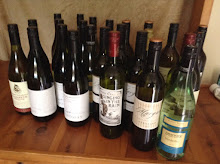One permanent resident is the satin bowerbird.
Bower birds are the scourge of any gardener and especially grapegrowers as they have a love of green vegetables and fruit and can strip a crop bare in a few days.
But we have overcome this by netting.
A male satin bowerbird has taken up residence under our huge bottlebrush (callistemon sp.) tree in the back yard. He has been there many years now.
He is a striking dark blue color.
The immature males and females look very much alike and are a grey green color.

The male builds a bower from twigs and grass and covers the surrounds in all sorts of blue objects like bottle tops, pegs and pieces of plastic.

Here he courts and mates with the female. During courting the male prances and struts around his bower offering the female items from his collection of blue objects, while making a series of hissing, chattering and scolding noises. Mating takes place in the avenue of the bower and the male may mate with several females in a single season.
Only the female builds a nest. This is a shallow, saucer-shaped construction of twigs and dry leaves above the ground in the upright outer branches of a tree. The nest is lined with fine dry leaves. The female lays one to three eggs, which she incubates.
Only the female builds a nest. This is a shallow, saucer-shaped construction of twigs and dry leaves above the ground in the upright outer branches of a tree. The nest is lined with fine dry leaves. The female lays one to three eggs, which she incubates.
She then raises the young on her own.




















No comments:
Post a Comment